Bihu
Bihu is a set of three important Assamese festivals in the Indian state of Assam[4]—Rongali or Bohag Bihu observed in April, Kongali or Kati Bihu observed in October, and Bhogali or Magh Bihu observed in January.[5] The Rongali Bihu is the most important of the three, celebrating spring festival. The Bhogali Bihu or the Magh Bihu is a harvest festival, with community feasts. The Kongali Bihu or the Kati Bihu is the sombre, thrifty one reflecting a season of short supplies and is an animistic festival.[6]
| Bihu | |
|---|---|
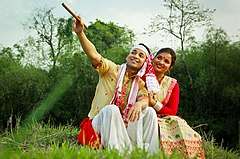 Bihu of Assam | |
| Official name | Bihu |
| Also called | Rongali Bihu (April) • rongali Bihu (October) • Bhogali Bihu (January) |
| Observed by | Assamese people |
| Type | Regional folk |
| Ends | Varies |
| Date | In the months of Bohag, Kaati and Maagh |
| Frequency | Tri-annual |
| Part of a series on the |
| Culture of Assam |
|---|
 |
|
Proto-historic
Classical Medieval
Modern |
|
|
|
Festivals
|
|
Religion Major
Others |
|
History
Archives
Genres
Institutions
Awards
|
|
Music and performing arts |
|
Media |
|
Symbols
|
The Rongali Bihu coincides the Assamese New year and as well as with other regions of Indian subcontinent, East Asia and South-East Asia, which follow the Hindu calendar and Buddhist calendar.[7] The other two Bihu festivals every year are unique to Assamese people. Like some other Indian festivals, Bihu is associated with agriculture, and rice in particular. Bohag Bihu is a sowing festival, Kati Bihu is associated with crop protection and worship of plants and crops and is an animistic form of the festival, while Bhogali Bihu is a harvest festival.[8][9] Assamese celebrate the Rongali Bihu with feasts, music and dancing. Some hang brass, copper or silver pots on poles in front of their house, while children wear flower garlands then greet the new year as they pass through the rural streets.[10]
The three Bihu are Assamese festivals with reverence for Krishna, cattle (Goru Bihu),[10] elders in family, fertility and mother goddess, but the celebrations and rituals reflect influences from Southeast Asia and Sino-Tibetan cultures.[11][12][13] In contemporary times, the Bihus are celebrated by all Assamese people irrespective of religion, caste or creed.[14] It is also celebrated overseas by the Assamese diaspora community living worldwide.
The term Bihu is also used to imply Bihu dance otherwise called Bihu Naas and Bihu folk songs also called Bihu Geet.
History
Although the modern form of Bihu is a synthesis of varied cultural elements from diverse ethnic groups like Austro-Asiatic, Tibeto-Burman, Indo-Aryan and Tai, it has deep roots in the indigenous culture.[15]
Indigenous origin
The origin of Bihu can be traced to the admix of the cultures of Austro-Asiatic, Tibeto-Burman and Indo-Aryan peoples.
The word Bihu has been derived from the Deori (a Boro-Garo language) word Bisu which means "excessive joy". This older form of Bihu continue among the Chutias, Sonowal Kacharis, Thengal-Kacharis, Morans, and Deoris and Motoks. These groups were known as Sadiyal Kacharis were associated with the Kingdom of Sadiya. The other branches of Bodo-Kacharis which include Boros, Dimasas, Rabhas, Tiwas, etc. have also been celebrating Bihu since ancient times. The Boros call it Baisagu, while the Dimasas, Tiwa and Rabha call it Bushu, Pisu, Dumsi respectively.[16][17]
In local folklore, it is said that Bordoisila (meaning north-westerly winds in Assamese) was the daughter of God Earth who married to a bridegroom of some distant land. Bordoisila visits her mother’s home once in year during spring time which indicates the beginning of Bihu and leaves after a few days which indicates the end of Bihu. Assam experience strong gale (wind) at that period which marks the beginning of Bihu and another strong gale after her departure which is devastating. The word Bordoisila is actually derived from the Bodo word Bordaisikhla which means "girl of storm" (Sikhla meaning girl and Bardai meaning storm). There is even a dance with the same name performed among Boro people during Baisagu which further proves that Bihu has origins in the Bodo-Kachari group.[18]
The first reference of Bihu can be found in the copperplate inscription of the Chutia king Lakshminarayan. The inscription was found in Ghilamara region of Lakhimpur district in the year 1935 and it was issued in the year 1401 A.D. It states that the king Lakshminarayan has donated land grants to Brahmins on the auspicious occasion of Bihu. It reads,
“Etasmay Shashana prada Lakshminarayana Nripa
Utrijya Bisuye Punya Ravidev Dvijanme”— Copper plate, Ghilamara(1401)
This means that on the pious occasion of Bihu, a Brahmin named Dvija Ravidev was granted land by the king. This indicates that Bihu played an important role in the social life of people of Assam at that period.
There is another popular saying among the people of Assam as,
“Dhul bai kot? Ratanpurot
Khul bai kot? Ratanpurot.”— Assamese folklore
Ratanpur was known to be the cultural capital of Chutia kingdom established by the king Ratnadhwajpal[19] which further indicates the popularity of Bihu and the Dhul among the people of that period. The wooden Khol played in Ratanpur in early times (similar to the Mayamora Khul, Manipuri Pung) was later turned into the terracotta Mridanga (similar to the ones played in eastern India) by the Vaishnavite saint Sankardev so that it could be used in art forms like dances and dramas.
Yet another reference of Bihu can be found in the Deodhai Buranji which mentions that the capital of the Chutia kingdom, Sadiya was suddenly attacked by the Ahom forces on the first day of Bihu/Bisu in 1524 (first Wednesday of Bohag/Vaisakha), when the people were busy celebrating Bihu. The Ahom general Phrasenmung Bogohain upon the advise of a Chutia general (who sided with the enemies) played the Bihu Dhul (on Ujha Bisu day i.e. 7th Bohag/Vaisakha) to trick the Chutias which ultimately led to their defeat.[20].
In early texts, Bohag Bihu celebrations started from the first week of Chaitra (Chot in Assamese) month. The period from the first week of Chaitra till the end was known as Raati Bihu or Chotor Bihu. During this period, young people danced at night in the grounds of the Than (temple). The last day of Chaitra or the first Tuesday of Bohag was when the Rati Bihu ended. This was known as the Uruka (derived from the Deori-Chutia Urukuwa meaning to end). The temple dancers Deodhani danced the entire night and were believed to be possessed by the goddess Kechai-khati (kolimoti), signaling that she had descended upon earth from heaven (Bihu nomai ona). This belief of the goddess arriving during the Bihu season each year can still be found in Bihu songs as,
"Kolimoti e bai ghuri Bohagoloi
Ahibi ne nai?
Ami thakim ami thakim
Baatoloi sai."
The day after Uruka,i.e. the first Wednesday was celebrated as Goru Bihu. This tradition of cattle rites is same as that followed by the Boros in Bwisagu indicating the common roots of both the festivals. During the night of Goru-bihu, people danced Bihu in separate groups in the Thans where animal sacrifice took place. After the sacrifices to the goddess, the young folk visited the households of the village, which was the start of Husori. This old tradition of starting Husori from the temple is still followed by the Deoris, some Sonowals, Chutias and Morans as well as the people of Sadiya. In other communities, the temple has been replaced by the Namghar.[21]The festivities of Bohag Bihu continued for a week and ended with the rite by which the goddess was bid farewell. In this rite, a boat was first prepared out of banana stem and decorated with flowers and offerings. Then, it was carried to the banks of the river where a duck/chicken was put inside the boat and allowed to float as a symbol of sacrifice. After performing the rite, the people returned to their homes, singing along the way with the beats of the Dhul and the tunes of the Pepa.
Some old Assamese Bihu folklore still hint to this tradition.
“Hasoti e chot Bisoti e chot.
Budhe Goru Bihu Mangale Uruka.
Bihu goi asili kot.”
“Boge dhari khale luitor hihu,
Mangal bare Uruka Budh bare Goru Bihu
Tar pasor dina Manisor Bihu.”
“Husori e chot asili kot.
Sadiyar ahotor tolot,
Husori e chot asili kot.
Ami je ulomu jot Dubori nogoje tot.”
“Kundilor agolit ukhokoi Himolu.
Tate loi kuruwai bah.
Sadiyar rajate sari haal goxani
Taloi namaskar koru.
Hunare jakhala Rupor hetamari
Ahe sari haali nami.”
The modern form of Bihu dance was derived from the Faat Bihu dance celebrated in Dhakuakhana, Lakhimpur. The performers were called by the Ahom king Rudra Singha in 1694 to dance in the royal arena Rang Ghar. The origin of Faat Bihu can be traced to Sadiya. The word Faat in Deori-Chutia language means "to migrate". After the defeat of the Sadiyal Kacharis in Sadiya, the survivors were displaced from Sadiya to different places in the kingdom. A group of these people moved from Sadiya, to Dibrugarh and finally settled down in Harhi Sapori, Dhakuakhana. These people had brought the idols of god and goddess along with them and established a temple now known as Harhi Dewaloi. It was here that the first form of modern Bihu dance was developed. Later, in the 19th century, this form of Bihu dance was adopted by the other communities as well and started being performed in Mahguli sapori, Dhakuakhana by Chutias, Sonowals, Deoris, Ahoms, Mishing, etc.[22]
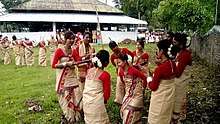
Tai-Shan contribution
The Tai-Shans/Tai-Ahoms (as called by the natives) upon their arrival in Assam found the natives (Tibeto-Burmans) celebrating a festival of cow-worship spraying fresh water. This ritual looked similar, to the ancestral Poin-Cham-Nyam ritual of their homeland. So, they called the existing festival of this land Poin-hu. Thus, the Bisu was later corrupted with Poin-hu to form what is today known as Bihu.[23][24]
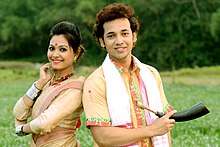
It is believed that the Bihu dance was given royal patronage by the Ahom king Rudra Singha in 1694. But, this view has been refuted by many authors. According to Padmeswar Gogoi, there is not a single mention of Bihu being performed in Rangghar in the Buranjis. The Satsari Buranji states that in the first floor of the Rangghar the places of the kings were pre-defined.[25] But, if one looks from the position of the kings chair, it is impossible to view the ground where Bihu dance was supposed to be performed. He also added that the Rangghar was mainly used for organizing buffalo and cock fights or wrestling and several positions were newly opened for these games. But, on the other hand no such post was created for Bihu. These facts prove that Bihu didn't receive much attention from the Ahom kings and remained a festival of the native people back then.
Indo-Aryan contribution
The Indo-Aryans upon their arrival in Assam helped in gradually sanskritisation of the native Bihu/Bisu to bring it to the present form. Being the pioneers of Astronomy, they further associated the term Bisu with the Visuvan day for coincidence of the Bohag Bihu with other springtime festivals observed elsewhere in India on this day and adopted the festival of the natives.[26]
The three Bihu Festivals
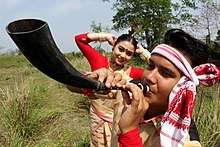
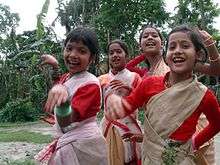
Bohag Bihu
Bohag Bihu (বহাগ বিহু)(mid-April, also called Rongali Bihu), the most popular Bihu celebrates the onset of the Assamese New Year (around 14–15 April) and the coming of Spring. This marks the first day of the Hindu solar calendar and is also observed in Bengal, Manipur, Mithila, Nepal, Orissa, Punjab, Kerala and Tamil Nadu though called by different names. It's a time of merriment and feasting and continues, in general, for seven days. The farmers prepare the fields for cultivation of paddy and there is a feeling of joy around. The women make pitha, larus (traditional food made of rice, coconut) various drinks by local tribes such as Chuje by Deoris/Chutias, Nam-Lao by Tai-Ahom, Aapong by Mising tribe and Jolpan which gives the real essence of the season.
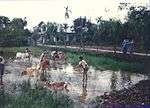
The first day of the bihu is called goru bihu or cow bihu, where the cows are washed and worshipped, which falls on the last day of the previous year, usually on 14 April. This is followed by manuh (human) bihu on 15 April, the New Year Day. This is the day of getting cleaned up, wearing new cloths and celebrating and getting ready for the new year with fresh vigor. The third day is Gosai (Gods) bihu; statues of Gods, worshiped in all households are cleaned and worshiped asking for a smooth new year.


The folk songs associated with the Bohag Bihu are called Bihugeets or Bihu songs. The form of celebration and rites vary among different demographic groups.
The Seven days
Bohag Bihu or Rongali Bihu festival continues for seven days and called as Xaat Bihu. The seven days are known as Chot Bihu, Goru Bihu, Manuh Bihu, Kutum Bihu, Senehi Bihu, Mela Bihu and Chera Bihu.
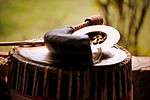
Kati Bihu

Kongali Bihu (mid-October, also called Kati-Bihu) has a different flavor as there is less merriment and the atmosphere has a sense of constraining and solemnity. During this time of the year, the paddy in the fields are in the growing stage and the granaries of the farmers are almost empty. On this day, earthen lamps (saki) are lit at the foot of the household tulsi plant, the granary, the garden (bari) and the paddy fields. To protect the maturing paddy, cultivators whirl a piece of bamboo and recite rowa-khowa chants and spells to ward off pests and the evil eye. During the evening, cattle are fed specially made rice items called pitha. The Bodo people light lamps at the foot of the siju (Euphorbia neriifolia) tree. This Bihu is also associated with the lighting of akaxi gonga or akaxbonti, lamps at the tip of a tall bamboo pole, to show the souls of the dead the way to heaven, a practice that is common to many communities in India, as well as Asia and Europe.[27]
Bhogali Bihu
Bhogali Bihu (mid-January, also called Magh Bihu) comes from the word Bhog that is eating and enjoyment.[28] It is a harvest festival and marks the end of harvesting season. Since the granaries are full, there is a lot of feasting and eating during this period. On the eve of the day called uruka, i.e., the last day of pausa, menfolk, more particularly young men go to the field, preferably near a river, build a makeshift cottage called Bhelaghar with the hay of the harvest fields and the bonfire or Meji, . the most important thing for the night. During the night, they prepare food and there is community feasting everywhere. There is also the exchange of sweets and greetings at this time. The entire night (called Uruka) is spent around a Meji with people singing bihu songs, beating Dhol, a typical kind of drums or playing games. Boys roam about in the dark stealing firewood and vegetables for fun. The next morning they take a bath and burn the main Meji. People gather around the Meji and throw Pithas (rice cakes) and betel nuts to it while burning it at the same time. They offer their prayers to the god of Fire and mark the end of the harvesting year. Thereafter they come back home carrying pieces of half burnt firewood for being thrown among fruit trees for favorable results. All the trees in the compound are tied to bamboo strips or paddy stems. Different types of sports like Buffalo-fight, Egg-fight, Cock-fight, Nightingale-fight etc. are held throughout the day. There are other conventional festivals observed by various ethnic-cultural groups. Me-dam-me-phi, Ali-aye-ligang, Porag, Garja, Hapsa Hatarnai, Kherai are few among them. The koch celebrates this bihu as pushna.[29]
Instruments used in Bihu
Bihu elsewhere
Bihu is also seen to be celebrated abroad. Many Bihu associations/committees exist elsewhere where this festival is celebrated with enthusiasm. The London Bihu Committee (LBC), UK is one of them among others.
Related festivals
The Bohag Bihu (Rongali Bihu) festive day is celebrated elsewhere but called by other name.[30][31][32] Some examples of related festivals in Asia include: Indian subcontinent:
- Vaisakhi in Punjab, India
- Vishu in Kerala, India
- Poila Boishakh in West Bengal, India
- Puthandu in Tamil Nadu, India
- Vaishak Ek in Nepal
- Sinhalese New Year in Sri Lanka.[33]
East Asia:
- Cambodian New Year in Cambodia, Thingyan in Burma, Songkran festival in Thailand and other festivals of East Asia and South-East Asia
However, this is not the universal new year for all Hindus. For some, such as those in and near Gujarat, the new year festivities coincide with the five day Diwali festival. For others, the new year falls on Ugadi and Gudi Padwa, which falls about two weeks before Bohag Bihu. Thus, Bohag Bihu is the New Year festival of the Indigenous Assamese people.[32]
See also
References
- "639 Identifier Documentation: aho – ISO 639-3". SIL International (formerly known as the Summer Institute of Linguistics). SIL International. Retrieved 29 June 2019.
Ahom [aho]
- "Population by Religious Communities". Census India – 2001. Ministry of Home Affairs, Government of India. Retrieved 1 July 2019.
Census Data Finder/C Series/Population by Religious Communities
- "Population by religion community – 2011". Census of India, 2011. The Registrar General & Census Commissioner, India. Archived from the original on 25 August 2015.
- "However, the festival to which utmost social importance is assigned by the people is Bihu, a festival that is neither pan-Indian in character nor observed with any religious fervour." (Barua 2009:213)
- Roshen Dalal (2010). Hinduism: An Alphabetical Guide. Penguin Books. p. 136. ISBN 978-0-14-341421-6.
- Sunita Pant Bansal (2005). Encyclopaedia of India. Smriti Books. p. 67. ISBN 978-81-87967-71-2.
- Praphulladatta Goswami (1966). The springtime bihu of Assam: a socio-cultural study. Gauhati. OCLC 474819.
- S. D. Sharma (2010). Rice: Origin, Antiquity and History. CRC Press. pp. 56, 60–61. ISBN 978-1-4398-4056-6.
- Goswami, Praphulladatta (1967). "Hindu and Tribal Folklore in Assam". Asian Folklore Studies. JSTOR. 26 (1): 19. doi:10.2307/1177697.
- Christian Roy (2005). Traditional Festivals: A Multicultural Encyclopedia. ABC-CLIO. pp. 479–480. ISBN 978-1-57607-089-5.
- Roshen Dalal (2010). Hinduism: An Alphabetical Guide. Penguin Books. p. 76. ISBN 978-0-14-341421-6.
- Uddipana Goswami (2014). Conflict and Reconciliation: The Politics of Ethnicity in Assam. Routledge. pp. 61–63. ISBN 978-1-317-55997-9.
- Amaresh Datta (1988). Encyclopaedia of Indian Literature. Sahitya Akademi. pp. 1277–1278. ISBN 978-81-260-1194-0.
- "Culture of Assam - Government Of Assam, India". Archived from the original on 25 May 2016. Retrieved 8 June 2016.
- (Barua 1973:38–41)
- Gogoi, Dinesh (2015). Baapoti Hahun Bihu. Guwahati.
- Gogoi, Dinesh(2015), Baapoti Hahun Bihu, Page 17-18, The root of the Bihu festival lies with the earliest immigrants of Assams, the Kacharis. It is specially attributed to the Sadiyal Kacharis which includes Chutias, Sonowals, and Deoris. The word Bihu is probably a derived form of "Bisu" celebrated by the Deoris, which stands for "excessive joy". Other festivals similar to it include the Baisagu of Bodos, Bushu of Dimasas, Pisu of Tiwas, and Dumsi of Rabhas.
- Bordoisila Bihu folklore
- Ratanpur, the capital of Ratnadhwajpal
- Bhuyan, Surya Kumar (2005) [1932]. Deodhai Assam Buranji. Guwahati.
- Barua, S.L. Chutiya Jatir Buranji. 2004, p. 390.
- Hakacham, Upen Rabha (2010). Origin of Bihu. Guwahati.
- Gandhiya, J. (2007). Jatiya Utsav Bihu(Samskriti Sourav). Guwahati.
- Gandhiya, J(2007), Jatiya Utsav Bihu(Samskriti Sourav), Page 3-4, It can also be stated that the term "Bisu" was perhaps corrupted with "Poin-hu" to give the term Bihu. The Tai-Shan immigrants, after they had reached Assam, saw the earlier settlers in festivities of cow-worship sprayingfresh water. This ritual looked similar, to the ancestral Poin-Cham-Nyam ritual of the Tai-Ahoms.
- [Bhuyan, S.K. Satsari Assam Buranji, 1960]
- Bhattacharya, Pramod chandra (1969). Asamar Loka Utsav. Guwahati.
- Goswami 1988, pp7-8
- Celebrating Nature's Bounty - Magh Bihu Archived 2012-01-17 at the Wayback Machine, Efi-news.com
- Sankalp India Foundation. "Bihu: A celebration of Assamese culture | Sankalp India Foundation". Sankalpindia.net. Retrieved 19 December 2012.
- Lau, Vishaal (14 July 2007). "Religions - Hinduism: Vaisakhi". BBC. Retrieved 19 July 2018.
- Crump, William D. (2014), Encyclopedia of New Year's Holidays Worldwide, MacFarland, page 114
- Karen Pechilis; Selva J. Raj (2013). South Asian Religions: Tradition and Today. Routledge. pp. 48–49. ISBN 978-0-415-44851-2.
- Peter Reeves (2014). The Encyclopedia of the Sri Lankan Diaspora. Didier Millet. p. 174. ISBN 978-981-4260-83-1.
Notes
- Barua, Hem (1973). "The Bihu Festival". Indian Literature. 16 (3/4): 35–43. JSTOR 24157200.CS1 maint: ref=harv (link)
- Barua, Maan (2009). "The Ecological Basis of the Bihu Festival of Assam". Folklore. 120 (2): 213–223. JSTOR 40646515.CS1 maint: ref=harv (link)
- Das, Debendra Prasad Rongali Bihu through the ages, The Assam Tribune, 14 April 2007.
- Dowerah, Sawpon Rongali Bihu-the spring festival of Assam, The Assam Tribune, 14 April 2007.
- Goswami, Prafulladatta (1988) Bohag Bihu of Assam and Bihu songs, Publication Board, Assam.
